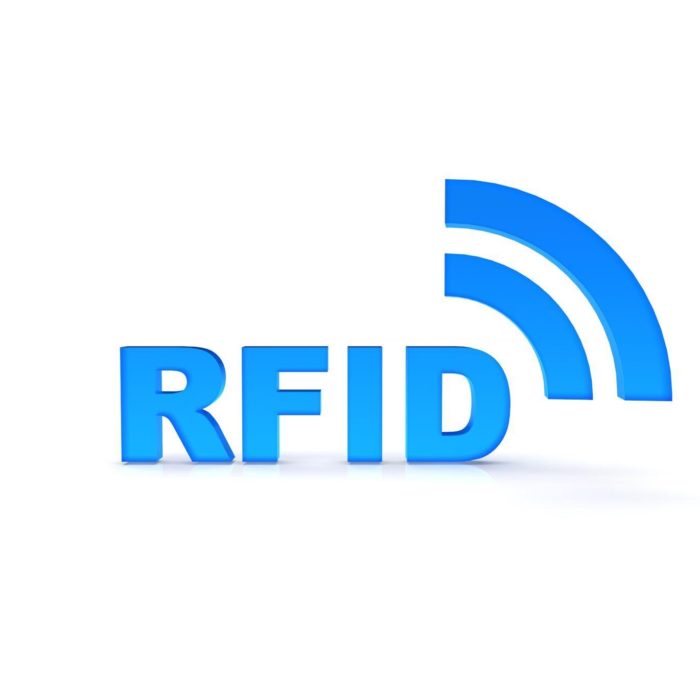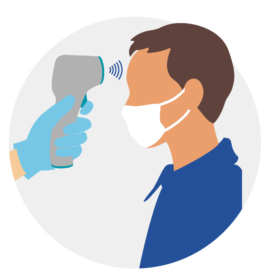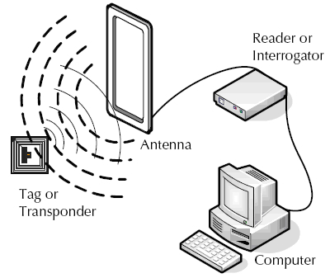RFID Application in COVID-19 Pandemic

At present, the coronavirus disease (COVID-19) is spreading around the world. It is a critical and important task to take thorough efforts to prevent and control the pandemic. Various ways have been applied to overcome the spread of this virus from conventional to modern ways, but this case is getting more and more every time. This is a new challenge for us to evolve research about how to reduce and prevent the Covid-19 disease.

The pandemic has not only raised opportunities to advance technology-based solutions but also provided a rare opportunity to study the research and practice of technology, including information management, work practices, and design and use of technologies. The quick transition to telehealth, telework, and online education in response to the coronavirus threat is a reminder that digital technology brings many benefits and can play an essential role in managing and reducing the risks caused by the lockdown during the pandemic and even after the pandemic. One of the strategic and effective use of technology information and software to prevent the spread of Covid-19 virus is RFID.
 Radio-frequency identification (RFID) is a technology that allows to store and retrieve a huge amount of data through electromagnetic transmission using radio-frequency (RF) devices and a strategically installed technological structure. RFID enables identification from a distance, and unlike earlier bar-code technology, it does so without requiring a line of sight. Furthermore, RFID systems can discern many different tags located in the same general area without human assistance.
Radio-frequency identification (RFID) is a technology that allows to store and retrieve a huge amount of data through electromagnetic transmission using radio-frequency (RF) devices and a strategically installed technological structure. RFID enables identification from a distance, and unlike earlier bar-code technology, it does so without requiring a line of sight. Furthermore, RFID systems can discern many different tags located in the same general area without human assistance.
How it works?
 A typical RFID system includes three components: an antenna or coil, a transceiver (with decoder) and a transponder (RF tag) electronically programmed with unique information. There is emission of radio signals by the antenna in order for the tag to be activated and data to be read and written to it. Antennas establish the communication between the tag and the transceiver. The transceiver is responsible for the data acquisition.
A typical RFID system includes three components: an antenna or coil, a transceiver (with decoder) and a transponder (RF tag) electronically programmed with unique information. There is emission of radio signals by the antenna in order for the tag to be activated and data to be read and written to it. Antennas establish the communication between the tag and the transceiver. The transceiver is responsible for the data acquisition.
RFID is one of the most frequently used electronics because of its advantages: reduces inventory control and provisioning costs, can access data in real-time, enables identification from longer distance than barcodes, can store large amounts of data additionally to a unique identifier, can be combined with sensors, etc. This technology produces various kinds of smart technologies in various fields, such as health, industry, social, and finance.

As smart people, we can use RFID to develop technological research to prevent the transmission of the Covid-19 virus. The following are some of the uses of RFID technology that can be applied during a pandemic.
1. Smart Healthcare System
 To date, only incomplete information is available on the host innate immune status of SARS-CoV-2–infected patients. As more people are infected, most are likely to generate an immune response. This may lead to a need for a community-wide immunity status classification, for example:
To date, only incomplete information is available on the host innate immune status of SARS-CoV-2–infected patients. As more people are infected, most are likely to generate an immune response. This may lead to a need for a community-wide immunity status classification, for example:
- Previously infected, now immune, non-infectious.
- Currently Infected
- Immunologically naive, still susceptible to infection
RFID within a biometric bracelet could be the solution. The bracelet would have a unique personal ID and be configured to communicate with a second device – either handheld or freestanding. A quick scan of the bracelet could retrieve an individual’s health status instantaneously displaying a ‘clear’ or ‘block’ signal to the device. Possible status codes could be color coded or show classifications such as ‘currently sick’, ‘recovered’, ‘in quarantine’ or ‘unknown’.
2. Smart Tracking and Monitoring System
A system design to monitor office space in accordance with a health protocol that limits the number of people in a room to a maximum of 50% of normal capacity. The design of this surveillance system is a crowd control tool based on RFID (Radio Frequency Identification) which is designed to be able to monitor the number of employees in a room using computer software as a UI (user interface).
 Employees who will enter or leave the room must have an ID (Identity) in the form of an RFID Tag which will be affixed to their respective nametags. When passing through the door, the employee’s ID will be recorded and entered in the history along with the time and body temperature when the employee enters or leaves.
Employees who will enter or leave the room must have an ID (Identity) in the form of an RFID Tag which will be affixed to their respective nametags. When passing through the door, the employee’s ID will be recorded and entered in the history along with the time and body temperature when the employee enters or leaves.
UI is used to monitor the room. If the room is full, a notification that the room is full will appear on the monitor installed in front of the entrance to the room, so that other employees cannot enter because the door will be automatically locked with the help of a servo motor. When an employee leaves the room, the warning will disappear and other employees can re-enter the room.
3. Smart Payment System
In this pandemic situation, all aspects need something practical, fast, and safe to break the chain of spread of Covid-19, especially in the payment aspect. One of the most widely applied technologies is cashless / e-payment systems. The cashless payment system is designed that is suitable for everyday use and is more efficient than the use of a debit card which takes time to queue and requires a lot of physical contact. The system is designed using an RFID-based smart card method. This payment system will run with a server on the local network, to simulate the state of the application in stores, vending machines, cooperatives, and canteens in offices, shopping centers, schools, campuses, and other places.
 The user can make payments or transactions on vendors or merchants that use this system by putting card near RFID reader on the device. It will forward UID data from RFID through a network to the server. UID is a unique ID registered on RFID card. Each of the RFID cards always has different UID. The server checks the database if there is matched UID and its balance. If the balance meets bill requirements, the server sends success feedback to the terminal device and passenger able to enter. When the balance does not reach the minimum fare, the user will get the notification that their payment failed and needs a top-up their balance first. The previous procedure will be repeated for each transaction.
The user can make payments or transactions on vendors or merchants that use this system by putting card near RFID reader on the device. It will forward UID data from RFID through a network to the server. UID is a unique ID registered on RFID card. Each of the RFID cards always has different UID. The server checks the database if there is matched UID and its balance. If the balance meets bill requirements, the server sends success feedback to the terminal device and passenger able to enter. When the balance does not reach the minimum fare, the user will get the notification that their payment failed and needs a top-up their balance first. The previous procedure will be repeated for each transaction.
RFID is a new technology that is currently being developed. Various ease of use and applications that can be combined with other technologies make RFID much researched. Many industries apply this technology because of its advantages which make it easier for workers to manage their tasks with lower risk than the previous use of technology.

However, there is still little use of RFID to reduce or overcome the problems caused by Covid-19. Further research is needed to apply RFID as a technology that can reduce the high number of Covid-19 cases in various aspects, especially health and social. This development is used as a form of concern for the community and as a form of implementing technology in the future.
Reference
Camacho-Cogollo, J. E., Bonet, I., & Lazanda, E. (2020). Chapter 4 – RFID technology in health care. In E. Iadanza, Clinical Engineering Handbook (Second Edition) (pp. 33-41). doi:https://doi.org/10.1016/B978-0-12-813467-2.00004-3
Domdouzis, K., Kumar, B., & Anumba, C. (2007). Radio-Frequency Identification (RFID) applications: A brief introduction. Advanced Engineering Informatics, 21(4), 350-355. doi:https://doi.org/10.1016/j.aei.2006.09.001
He, W., Zhang, Z. (., & Li, W. (2021, April). Information technology solutions, challenges, and suggestions for tackling the COVID-19 pandemic. International Journal of Information Management, 57. doi:https://doi.org.proxy.undip.ac.id/10.1016/j.ijinfomgt.2020.102287
Herdiyanto, D. W., Setiabudi, D., & Chaidir, A. R. (2020). Electronic transaction system for user authentication and e-payment application based on RFID smart card. AIP Conference Proceedings, 2278(1). doi:https://doi.org/10.1063/5.0014687
Juhana, A. (2021). Perancangan Alat Pencegah Kerumunan. Jurnal Sistem Cerdas, 4(1), 18-24. doi:https://doi.org/10.37396/jsc.v4i1.116
Kaur, M., Sandhu, M., Mohan, N., & Sandhu, P. S. (2011). RFID Technology Principles, Advantages, Limitations & Its Applications. International Journal of Computer and Electrical Engineering, 3(1), 151.
Lahtela, A. (2009). A Short Overview of the RFID Technology in Healthcare. Fourth International Conference on Systems and Networks Communications, 165-169. doi:https://doi.org/10.1109/ICSNC.2009.77
Want, R. (2006, February 13). An Introduction to RDID Technology. 5(1), 25-33. doi:https://doi.org/10.1109/MPRV.2006.2
Weisman, Y., Tan, A. M., & Fuss, F. K. (2020). Use of wearable technology to enhance response to the Coronavirus (COVID-19) pandemic. Public health, 185, 221–222. doi:https://doi.org/10.1016/j.puhe.2020.06.048
Ye, J. (2020). The Role of Health Technology and Informatics in a Global Public : Practices and Implications From the COVID-19. JMIR MEDICAL INFORMATICS, 8(7). doi:https://doi.org/10.2196/19866
